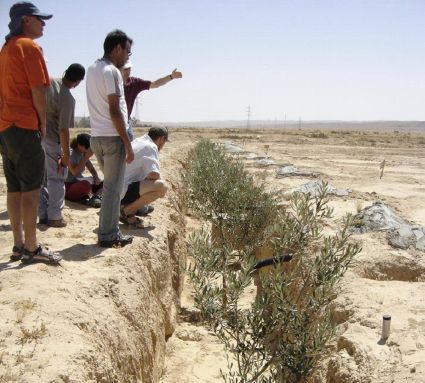Grape and Olive Runoff Farming
Olives and grapes, two major crops of Mediterranean Basin agriculture, have been in cultivation for thousands of years. Israel today produces some 62,000 tons of olives and 120,000 tons of grapes annually, valued at approximately $38 million (NIS 165 million) and $91 million (NIS 395 million), respectively. In order to advance thehorticulture of these crops in presently uncultivated low-precipitation regions, improved approaches that provide sufficient low-cost irrigation water are essential. Researchers at the Blaustein Institutes for Desert Research are developing runoff harvesting techniques for olive orchards and vineyards that could enable Mediterranean basin residents in dryland regions more profitable raising of these crops.
A. Olives
While most olive orchards in Israel are planted in areas of over 400 mm. of precipitation per year, in many Mediterranean countries such as Egypt, Tunisia,Spain and Portugal, nonirrigated olive plantations are planted in regions having only 200 to 400 mm. In order to cope with this low precipitation, trees are planted far apart to lessen competition for soil water. This, however, leads to a tremendous waste of water due to evaporation off the nearly bare soil surface.
The runoff harvesting team headed by Prof. Pedro Berliner is digging meter-deep trenches in experimental plots on the BIDR Wadi Mashash runoff-farm. The trenches are dug perpendicular to surface runoff, which flows into and is trapped by them (see Fig. 4). It then infiltrates vertically and laterally into the soil, whose limited surface area reduces evaporation. Because of the harvested precipitation, olive tree saplings can be planted much closer together in the meter-deep excavations than would be possible in an open field. Once the trees develop and send out theircanopies, they also shade the trench, further reducing evaporative loss. Measurements taken in these studies enable determination of the minimum effective distance between trenches and optimal spacing of trees to maximize olive production. This approach should enable increased olive oil production in arid regions throughout the Middle East, including Israel.

Fig. 4. Wadi Mashash runoff-farm in the Negev desert of israel, located 20 km south of Beer Sheva and 60 km from Mediterranean at elevation of 400 m a.s.l, with 115 mm mean annual rainfall. The trenches are dug perpendicular to surface runoff, which flows into and is trapped by them.
B. Grapes
Because of the convenience of grapes as a snack or for winemaking, this fruit has have been on the human diet since well before the start of history. Archaeologists, for example, have uncovered 9,000-year-old grape pips in a site in Caucasian Georgia, now considered the birthplace of the wine industry. Wild grapes are distributed worldwide, particularly in the Mediterranean basin – and eastward through Asia, the East Indies, to Austrialia. They are extensively found in North America as well. Because of its clusters of great beauty that sport extremely sweet, juicy fruits, it is no wonder that grapes were one of the first plants to be collected and subsequently domesticated by humans.
The first written reference to vineyards is in the earliest known document, the 3200-year-old Mesopotamian cuneiform tablets recording The Epic of Gilgamesh. The Bible is also full of references to viniculture, as are early Greek, Roman, and Egyptian writings. Naturally, modern grape cultivation – paralleling its natural distribution – spans all continents and covers some 10 million hectares (25 million acres), more than any other single fruit plant. In Israel, there are 7350 hectares(18,375 acres) of vineyards.
In order to improve the profitability and expand the growth of grapevines in marginal lands, researchers of the BIDR runoff harvesting team took a close look at vineyards in Uzbekistan in west-central Asia. In this country, particularly in the Sanzar river basin, the local population is primarily employed in growing and processing grapes. Due to heavy exploitation of the river to irrigate vineyards and other agricultural products, grape-growing activity at the river’s arid exit point is seriously restricted by extremely limited water flow. However, there is sufficient natural precipitation during the spring, which if harvested and stored in the soil could be used by plants during the dry summer months when the grapes ripen. By trapping runoff in the Sanzar basin, farmers could increase the areas used for agriculture and increase crop and vineyard yields in presently farmed lands.
In this theoretical study, the BIDR group, comprised of Gennady Carmi, Pedro Berliner and Arnon Karnieli, collaborated with Lev Poberzsky out on experimental plots, the researchers were able to calibrate a widely used runoff forecasting technique known as the KINEMAT model. This tool, applicable to small watersheds, is based on geographical, geological and soil properties that determine runoff characteristics. Because much of the KINEMAT input data is available from local measurements and remote-sensing approaches, water runoff can be predicted for different points of the watershed. Because vineyard yields are clearly dependent on water availability (data for which is available in the literature), the best location and vine-planting densities can be determined to make maximum use of the surface runoff as the sole source of water. This approach, known as the “optimum watershed management. technique” is being further evaluated in Uzbekistan and experimental grape vine plots will be planted to verify the usefulness of this approach under real field conditions.
Previous section Next section